Young people of all ages can learn important, timeless life lessons from history. Studies show that young people who engage in more nonfiction reading will build more background knowledge, which in turn will give them a greater foundation for all other reading. Here are a few recently published books—some nonfiction and some fiction based on real, historical events—that will inform and entertain readers.
Ages 4–8
Independence Cake: A Revolutionary Confection Inspired by Amelia Simmons, Whose True History Is Unfortunately Unknown. Deborah Hopkinson. Ill. Giselle Potter. 2017. Schwartz & Wade/Random House.
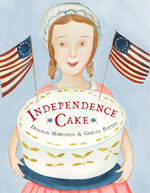 In an introduction, Deborah Hopkinson informs readers that Independence Cake is a fictional story about Amelia Simmons, author of American Cookery. First published in 1796 and the first known cookbook written by an American, Simmons adapted English recipes and cooking techniques. Giselle Potter’s watercolor-and-ink illustrations provide colorful details that complement Hopkinson’s imagined life story of Amelia Simmons in which local fame as a baker led to her creation of thirteen Independence Cakes (one for each of the thirteen colonies) for President George Washington’s inauguration celebration. Back matter includes an author’s note and online sources of Election Day cake recipes.
In an introduction, Deborah Hopkinson informs readers that Independence Cake is a fictional story about Amelia Simmons, author of American Cookery. First published in 1796 and the first known cookbook written by an American, Simmons adapted English recipes and cooking techniques. Giselle Potter’s watercolor-and-ink illustrations provide colorful details that complement Hopkinson’s imagined life story of Amelia Simmons in which local fame as a baker led to her creation of thirteen Independence Cakes (one for each of the thirteen colonies) for President George Washington’s inauguration celebration. Back matter includes an author’s note and online sources of Election Day cake recipes.
—CA
Margaret and the Moon: How Margaret Hamilton Saved the First Lunar Landing. Dean Robbins. Ill. Lucy Knisley. 2017. Alfred A. Knopf/Random House.
 Growing up, Margaret was curious about everything and loved to solve complicated math problems. When she discovered computers, she taught herself to code, using her problem-solving skill to write computer programs to perform increasingly more complex tasks. In 1964, she began working with NASA as software director for Project Apollo, and in 1969 became a hero of the Apollo 11 mission when a computer overload threatened its success. “Had Margaret thought of everything that could go wrong with a lunar landing?” Yes, and the safe landing on the moon of the lunar module Eagle was accomplished. An engaging text and cartoon illustrations make this life story of Margaret Heafield Hamilton accessible to young readers. Back matter includes an author’s note, bibliography, and an additional reading list.
Growing up, Margaret was curious about everything and loved to solve complicated math problems. When she discovered computers, she taught herself to code, using her problem-solving skill to write computer programs to perform increasingly more complex tasks. In 1964, she began working with NASA as software director for Project Apollo, and in 1969 became a hero of the Apollo 11 mission when a computer overload threatened its success. “Had Margaret thought of everything that could go wrong with a lunar landing?” Yes, and the safe landing on the moon of the lunar module Eagle was accomplished. An engaging text and cartoon illustrations make this life story of Margaret Heafield Hamilton accessible to young readers. Back matter includes an author’s note, bibliography, and an additional reading list.
—CA
Patrick and the President. Ryan Tubridy. Ill. P. J. Lynch. 2017. Candlewick.
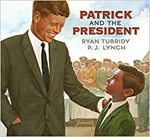 In this historically-inspired fictional story, Patrick, a young Irish boy, meets President John F. Kennedy during his 1963 visit to his ancestral home in Dunganstown, Ireland. Patrick sings with his class for the President, and attends the Kennedy family reception where he serves President Kennedy a special dessert and shakes hands with him. “Don’t ever wash that lucky hand of yours!” said Patrick’s mam. Realistic watercolor illustrations in soft hues capture the anticipation of Patrick and his classmates as they meet the President and create memories for a lifetime. Endpapers include the lyrics of “The Boys of Wexford,” which school children sang as part of Kennedy’s 1963 welcome to Ireland. Back matter includes a day-by-day itinerary of the President’s trip to Ireland accompanied by black-and-white photos.
In this historically-inspired fictional story, Patrick, a young Irish boy, meets President John F. Kennedy during his 1963 visit to his ancestral home in Dunganstown, Ireland. Patrick sings with his class for the President, and attends the Kennedy family reception where he serves President Kennedy a special dessert and shakes hands with him. “Don’t ever wash that lucky hand of yours!” said Patrick’s mam. Realistic watercolor illustrations in soft hues capture the anticipation of Patrick and his classmates as they meet the President and create memories for a lifetime. Endpapers include the lyrics of “The Boys of Wexford,” which school children sang as part of Kennedy’s 1963 welcome to Ireland. Back matter includes a day-by-day itinerary of the President’s trip to Ireland accompanied by black-and-white photos.
—NB
Ages 9–11
Refugee. Alan Gratz. 2012. Scholastic.
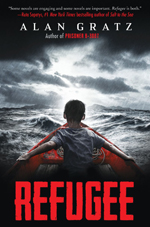 Three young people from different places and times—Josef, a Jewish boy in Nazi Germany in 1938; Isabel, a girl living near Havana under the dictatorship of Fidel Castro in 1994; and Mahmoud, living in war-torn Aleppo, Syria, in 2015—have the same goal: to flee their homelands with their families. Written in alternating short chapters from the points of view of Josef, Isabel, and Mahmoud, Gratz’s novel is a fast-paced, action-packed adventure story. It is also a compelling and heartrending historical exploration of the plight of immigrants who take incredible journeys to survive, sustained by the quest for freedom and the hope of reaching a place in which their families can rebuild their lives. Maps help readers follow the three families’ journeys, and in an author’s note, Gratz identifies the historical background against which the fictional stories of Josef, Isabel, and Mahmoud are set.
Three young people from different places and times—Josef, a Jewish boy in Nazi Germany in 1938; Isabel, a girl living near Havana under the dictatorship of Fidel Castro in 1994; and Mahmoud, living in war-torn Aleppo, Syria, in 2015—have the same goal: to flee their homelands with their families. Written in alternating short chapters from the points of view of Josef, Isabel, and Mahmoud, Gratz’s novel is a fast-paced, action-packed adventure story. It is also a compelling and heartrending historical exploration of the plight of immigrants who take incredible journeys to survive, sustained by the quest for freedom and the hope of reaching a place in which their families can rebuild their lives. Maps help readers follow the three families’ journeys, and in an author’s note, Gratz identifies the historical background against which the fictional stories of Josef, Isabel, and Mahmoud are set.
—CA
The Whydah: A Pirate Ship Feared, Wrecked & Found. Martin W. Sandler. 2017. Candlewick.
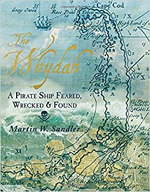 The Whydah, which sunk off the coast of Cape Cod during a storm on April 26, 1717, and was found in 1985, is the only shipwreck that has been authenticated as a pirate ship. Marine archaeologists have studied this “sunken time capsule” with its artifacts that provide evidence of pirate life that differs from their representations in popular movies and books. Sandler’s narrative, accompanied by biographical sketches, maps, charts, and photographs, chronicles the Whydah’s transformation from slavery ship to the mightiest and greediest pirate ship of the day. Insets include information about the history of slavery in the Americas, the Articles of Agreement (rules for pirates), the history of the Jolly Roger pirate flag, pirate attack strategies, coins as windows to the past, and other relevant and interesting topics. Back matter includes source notes, a bibliography, and an index.
The Whydah, which sunk off the coast of Cape Cod during a storm on April 26, 1717, and was found in 1985, is the only shipwreck that has been authenticated as a pirate ship. Marine archaeologists have studied this “sunken time capsule” with its artifacts that provide evidence of pirate life that differs from their representations in popular movies and books. Sandler’s narrative, accompanied by biographical sketches, maps, charts, and photographs, chronicles the Whydah’s transformation from slavery ship to the mightiest and greediest pirate ship of the day. Insets include information about the history of slavery in the Americas, the Articles of Agreement (rules for pirates), the history of the Jolly Roger pirate flag, pirate attack strategies, coins as windows to the past, and other relevant and interesting topics. Back matter includes source notes, a bibliography, and an index.
—NB
Ages 12–14
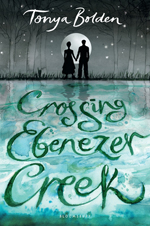 Crossing Ebenezer Creek. Tonya Bolden. 2017. Bloomsbury.
Crossing Ebenezer Creek. Tonya Bolden. 2017. Bloomsbury.
The freedom Mariah has always longed for seems to be a possibility as she and her younger brother, Zeke, and others enslaved on the Chaney plantation join the march of General Sherman’s 14th Army Corps through Georgia following a raid by Union soldiers. As a relationship grows between Mariah and Caleb, a young black man working with the corps, she begins to dream of a home of her own with a man she loves. The hardships and dangers of the march are severe, but for Mariah, the struggles in freedom are nothing like the struggles in slavery. “Now the struggles of the march were hitched to striving for a new life.” An author’s note provides a context for this beautifully-written, carefully-researched novel which tells a personal story of a little-known event of the Civil War, the tragedy of “the betrayal at Ebenezer Creek” on December 9, 1864.
—CA
Double Cross: Deception Techniques in War. Paul B. Janeczko. 2017. Candlewick.
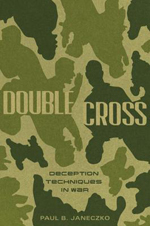 In this companion to Top Secrets: A Handbook of Codes, Ciphers, and Secret Writing (2006) and The Dark Game: True Spy Stories from Invisible Ink to CIA Moles (2010), Paul Janeczko chronicles the use of deception in war throughout history. Focusing on the use of deception during World War I, World War II, and the Korean, Vietnam, and Gulf Wars, Janeczko provides numerous examples of the interplay of various deception tactics used in military operations (such as the D-Day invasion of Normandy on June 6, 1944) in an informative, accessible text, complemented by captioned photographs and maps. Each chapter includes an interesting sidebar on a related topic such as the use of signals and ciphers in the Civil War, the code-breaking operation at Bletchley Park in World War II, and the important role of the Global Positioning System (GPS) for communication during Operation Desert Storm, the second phase of the Gulf War. Back matter includes source notes, a bibliography, image credits, and an index.
In this companion to Top Secrets: A Handbook of Codes, Ciphers, and Secret Writing (2006) and The Dark Game: True Spy Stories from Invisible Ink to CIA Moles (2010), Paul Janeczko chronicles the use of deception in war throughout history. Focusing on the use of deception during World War I, World War II, and the Korean, Vietnam, and Gulf Wars, Janeczko provides numerous examples of the interplay of various deception tactics used in military operations (such as the D-Day invasion of Normandy on June 6, 1944) in an informative, accessible text, complemented by captioned photographs and maps. Each chapter includes an interesting sidebar on a related topic such as the use of signals and ciphers in the Civil War, the code-breaking operation at Bletchley Park in World War II, and the important role of the Global Positioning System (GPS) for communication during Operation Desert Storm, the second phase of the Gulf War. Back matter includes source notes, a bibliography, image credits, and an index.
—CA
Ages 15+
Magellan: Over the Edge of the World. Laurence Bergreen. 2017. Roaring Brook.
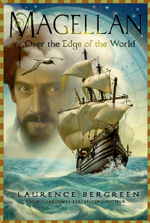 This young readers’ edition of Bergeen’s Over the Edge of the World: Magellan’s Terrifying Circumnavigation of the Globe (2003) offers a true adventure story set in the age of exploration and discovery that expands the textbook story of Portuguese navigator Ferdinand Magellan (1480–1521). With Magellan as captain general, the Armada de Molucca of five ships and 260 sailors set sail on the Atlantic Ocean in 1519 under the Spanish flag. The expedition to the Spice Islands was plagued by treacherous sailing conditions over uncharted waters, storms, harsh weather, illness, starvation, and mutiny. Magellan was killed in the Philippines during a confrontation with natives in 1521. The following year, one remaining ship, the Victoria, returned to Seville with only eighteen survivors, completing the circumnavigation of the globe. The history of this important maritime expedition includes a list of major characters, maps, and captioned illustrations. Back matter includes source notes, a bibliography, and an index.
This young readers’ edition of Bergeen’s Over the Edge of the World: Magellan’s Terrifying Circumnavigation of the Globe (2003) offers a true adventure story set in the age of exploration and discovery that expands the textbook story of Portuguese navigator Ferdinand Magellan (1480–1521). With Magellan as captain general, the Armada de Molucca of five ships and 260 sailors set sail on the Atlantic Ocean in 1519 under the Spanish flag. The expedition to the Spice Islands was plagued by treacherous sailing conditions over uncharted waters, storms, harsh weather, illness, starvation, and mutiny. Magellan was killed in the Philippines during a confrontation with natives in 1521. The following year, one remaining ship, the Victoria, returned to Seville with only eighteen survivors, completing the circumnavigation of the globe. The history of this important maritime expedition includes a list of major characters, maps, and captioned illustrations. Back matter includes source notes, a bibliography, and an index.
—CA
Night Witches. Kathryn Lasky. 2017. Scholastic.
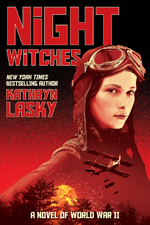 It's 1941; World War II is in full swing and the Germans are surrounding Stalingrad, intent on obliterating the city. After her grandmother and mother are killed and her home destroyed in raids on their town, 16-year-old Valya heads out on her own to not only survive, but to help. Taught to fly by her father, who was a major in the Russian Air Force, she longs to join her sister, Tatyana, as a member of the Night Witches, a band of young female Soviet pilots who bomb Nazi supply lines and clear the way for the troops, but she does not qualify because she is too young. Sneaking her way onto the base, Valya works her way up from the ground crew to the cockpit, where she is eventually able to prove herself. When Tatyana is captured by the Germans, Valya knows that it is up to her to rescue her sister, and it will entail precision timing and more than a little luck.
It's 1941; World War II is in full swing and the Germans are surrounding Stalingrad, intent on obliterating the city. After her grandmother and mother are killed and her home destroyed in raids on their town, 16-year-old Valya heads out on her own to not only survive, but to help. Taught to fly by her father, who was a major in the Russian Air Force, she longs to join her sister, Tatyana, as a member of the Night Witches, a band of young female Soviet pilots who bomb Nazi supply lines and clear the way for the troops, but she does not qualify because she is too young. Sneaking her way onto the base, Valya works her way up from the ground crew to the cockpit, where she is eventually able to prove herself. When Tatyana is captured by the Germans, Valya knows that it is up to her to rescue her sister, and it will entail precision timing and more than a little luck.
—NB
Maid of the King’s Court. Lucy Worsley. 2017. Candlewick.
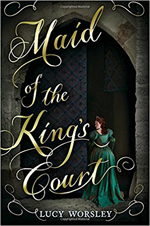 Twelve-year old Elizabeth Rose Camperdowne has accepted that it is her duty to save her impoverished but noble family by marrying well. After her engagement falls through in a scandal, she is sent to Trumpton Hall to train to become a lady. It is not long before Eliza and her cousin Katherine are sent as maids of honor to serve King Henry VIII’s latest wife, Anne of Cleves. Hoping for lucrative marriage matches, they are immediately drawn into court intrigue. When Anne doesn’t produce an heir, she is dismissed, and Katherine is chosen as the king’s next wife. This story follows the fictional character, Eliza, through age 18, when Katherine is beheaded for treason. In the epilogue, British historian Worsley tells how she used her knowledge of Hampton Court Palace to create this fictional version of Tudor history that she hopes will provide insights into Katherine Howard’s life.
Twelve-year old Elizabeth Rose Camperdowne has accepted that it is her duty to save her impoverished but noble family by marrying well. After her engagement falls through in a scandal, she is sent to Trumpton Hall to train to become a lady. It is not long before Eliza and her cousin Katherine are sent as maids of honor to serve King Henry VIII’s latest wife, Anne of Cleves. Hoping for lucrative marriage matches, they are immediately drawn into court intrigue. When Anne doesn’t produce an heir, she is dismissed, and Katherine is chosen as the king’s next wife. This story follows the fictional character, Eliza, through age 18, when Katherine is beheaded for treason. In the epilogue, British historian Worsley tells how she used her knowledge of Hampton Court Palace to create this fictional version of Tudor history that she hopes will provide insights into Katherine Howard’s life.
—NB
Nancy Brashear is Professor Emeritus of English from Azusa Pacific University, in Azusa, California. Carolyn Angus is former director of the George G. Stone Center for Children's Books, Claremont Graduate University, in Claremont, California.